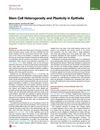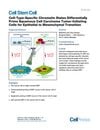Unmasking Stem Cell Dynamics in Mammary Branching Morphogenesis
February 2017
in “
Developmental Cell
”
TLDR Mammary stem cells drive mammary gland growth by branching and cell mixing.
Scheele et al. (2017) investigated mammary stem cells (MaSCs) during mammary gland branching morphogenesis, revealing that MaSCs are primarily located in terminal end buds (TEBs) and are unipotent, contributing to either luminal or basal cell lineages. The study used lineage tracing and theoretical modeling to show that TEB bifurcation, rather than side branching, drives ductal growth, with MaSCs proliferating in TEBs. The research highlighted the dynamic positional regulation of MaSCs, where their behavior is influenced by their location within the TEB, with border MaSCs contributing to duct growth and tip MaSCs favoring self-renewal. Additionally, significant intra-TEB cell migration was observed, suggesting that MaSCs act as an equipotent pool during branching. The study emphasized the need for further research to understand how TEB-associated MaSC behaviors are regulated by microenvironmental signals and how diverse stem cell states coordinate to form complex tissues.




